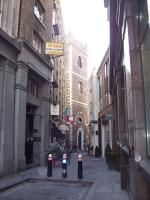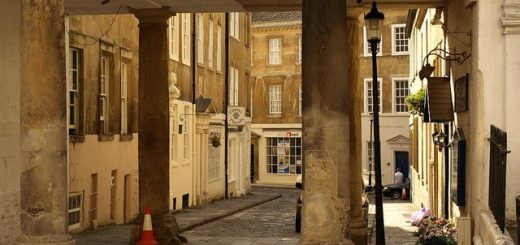SS Great Britain
The SS Great Britain ranks amongst the most famous ships every built. Over 160 years old she now rests in same the dry dock that was specially created for her construction in Bristol harbour. The dock itself is now airtight and environmentally controlled to preserve the mighty vessel and prevent her wrought iron hull from being eaten by corrosion. As part of the National Historical Fleet, she is now a major tourist attraction as a museum ship. Over the length of her career the ship has seen many changes and has ferried crew, cargo, soldiers and passengers around the world, but do some of these still remain to haunt the vessel?
 Designed by Isambard Kingdom Brunel (Chief Engineer for the Great Western Steamship Company), Thomas Guppy, Christopher Claxton and William Patterson, the SS Great Britain was the largest ship afloat when she was launched on 19 July 1843 with Prince Albert in attendance. With an iron hull and 16’ screw propeller she was also the most modern steam powered passenger ship in service.
Designed by Isambard Kingdom Brunel (Chief Engineer for the Great Western Steamship Company), Thomas Guppy, Christopher Claxton and William Patterson, the SS Great Britain was the largest ship afloat when she was launched on 19 July 1843 with Prince Albert in attendance. With an iron hull and 16’ screw propeller she was also the most modern steam powered passenger ship in service.
Her maiden voyage began on 26 July 1845 with a passage to New York that took 14 days for her to cross the Atlantic. Her travels to America were generally uneventful and unfortunately not very profitable. Her life as a transatlantic luxury passenger liner was to quickly change though, for in November 1846 she famously ran aground at Dundrum Bay in Ireland, damaging her engines. As the hull remained intact, James Bremner and the HMS Birkenhead managed to refloat her on 27 August 1847, though the cost for the Great Western Steamship Company was too much to bare and they went bankrupt.
 The SS Great Britain was sold to Gibbs Bright & Co who used her between 1852 and 1876 as an Emigrant Clipper. For this new purpose she was modified with a new engine, additional funnel, new deck house and interior was redesigned to accommodate 750 passengers (originally designed for 360 passengers). She proved to a great favourite and considered to be a very reliable ship. During her time as an Emigrant Clipper she made 32 voyages which included in 1861 taking the first English cricket team to Australia.
The SS Great Britain was sold to Gibbs Bright & Co who used her between 1852 and 1876 as an Emigrant Clipper. For this new purpose she was modified with a new engine, additional funnel, new deck house and interior was redesigned to accommodate 750 passengers (originally designed for 360 passengers). She proved to a great favourite and considered to be a very reliable ship. During her time as an Emigrant Clipper she made 32 voyages which included in 1861 taking the first English cricket team to Australia.
During the 1855 the British Government needed her to ferry troops to the Crimea. During the Crimean War she was to carry 44,000 soldiers. Years later she would also be called upon to carry the 17th Lancers and 8th Hussars during the Indian Mutiny.
 In 1882 she took on an entirely different role. The older the SS Great Britain got, the more her owners struggled to keep her registered as a passenger carrying vessel and as a result she was converted to carry coal instead. Her engines were removed and she became a sailing vessel, taking coal mined in Wales around the Cape Horn to San Francisco. Disaster struck however on her third trip and a fire forced her to seek shelter in Port Stanley, on the Falkland Islands. She was deemed to be expensive to repair was sold to the Falklands Island Company who used her as a hulk to store coal and wool.
In 1882 she took on an entirely different role. The older the SS Great Britain got, the more her owners struggled to keep her registered as a passenger carrying vessel and as a result she was converted to carry coal instead. Her engines were removed and she became a sailing vessel, taking coal mined in Wales around the Cape Horn to San Francisco. Disaster struck however on her third trip and a fire forced her to seek shelter in Port Stanley, on the Falkland Islands. She was deemed to be expensive to repair was sold to the Falklands Island Company who used her as a hulk to store coal and wool.
In 1937 her hull was considered to be no longer water tight and the ship was beached and scuttled. On 13th December 1939, HMS Exeter, HMS Cumberland, HMA Ajax and HMS Achilles found the German Pocket Battleship Admiral Graf Spee at the Battle of the River Plate. Exeter was forced to withdraw from the battle after taking severe damage and she limped to the Falkland Islands for emergency repairs. Iron plates from the SS Great Britain’s hull were used to repair Exeter during, enabling her to make it to Devonport for full repairs. The SS Great Britain also had souvenirs made from it’s timbers and sold to make money to build Spitfires at the start of the war.
 In 1970 she was salvaged. Refloated then mounted on a barge, she was towed 8000 miles back home to Bristol, where her keel had first been laid in 1839. It would then take 35 years of conservation and restoration to return her to her to how she was as Brunel’s passenger liner.
In 1970 she was salvaged. Refloated then mounted on a barge, she was towed 8000 miles back home to Bristol, where her keel had first been laid in 1839. It would then take 35 years of conservation and restoration to return her to her to how she was as Brunel’s passenger liner.
The Ghosts
Since the SS Great Britain returned to Bristol in 1970 there have been several incidents that have supported the case for the ship being haunted.
Weather Deck
In 1992/93 Sonny Graffo, a 17 year old student of travel and tourism who was doing a work placement in the souvenir shop had a strange experience when touring the ship. An interview with Sonny appeared in the Bristol Evening Post 15 years later.
“I was looking across a deep chasm into the bowels of the ship, about 30 or 40 feet below me, and there were beams of wood going across the gantries…I did a double-take and saw a chap sat on a beam of wood, staring across the gap at me.”
“He was wearing a white-collared shirt, had broad shoulders, a grey-white beard and looked scruffy. He was just sat there swinging his legs, and looked like he had been dragged through a hedge backwards, a bit like Captain Birdseye.”
“I thought he was a workman and called across to him, but he just sat there staring at me. Then I wondered how he could have got there, as there was no way of getting out to the plank.”
Going back to the shop, he was told it was probably “Johnny”, an apparition that had been seen before.
“I went white and the hairs on the back of my neck stood up as I wondered if I had seen a ghost,”
“I just froze when she told me the story, and when I saw the picture of Captain Gray it was strikingly similar.”
Captain John Gray disappeared from the ship mid journey one night in 1872. It was thought to be suicide.
Promenade Deck
A security officer reported the following experiences from his checking the ship in the evening.
“I saw a door move backwards and forwards and heard noises onboard, including the sound of locked doors slamming near the Captain’s Cabin. “
“I actually watched a door handle turn clockwise slowly and when I tried to open the door, it was locked. When I used my key to open the door, there was no one in the room. “
“Then I heard a bang and heavy footsteps at the other end of the Promenade Deck, and watched a door slam shut. When I checked it, the door was locked”.
 Phantom piano music was also heard two staff members (including the Ships Steward – Bob Evans), though no one was at the piano and the lid was closed. I must admit that when my wife and I were touring the ship and suddenly encountered piano playing it was so unexpected we got a shock, luckily there was a living pianist sat at the piano though.
Phantom piano music was also heard two staff members (including the Ships Steward – Bob Evans), though no one was at the piano and the lid was closed. I must admit that when my wife and I were touring the ship and suddenly encountered piano playing it was so unexpected we got a shock, luckily there was a living pianist sat at the piano though.
Forward Hold
Derek Sinclair a Conservation Consultant was working in the forward hold one night alone. He distinctly heard the sound of boots on stairs in the nearby Crew Quarters. Going to check he found the compartment empty and his colleague in the site office confirmed that no else has been on the ship at that time.
Other strange experiences have included the face of a small child being seen by a member of staff near the Steerage section and another member of staff has seen a leg vanish through a door.
The SS Great Britain has been featured on Living TV’s ‘Most Haunted’.


















Recent Comments